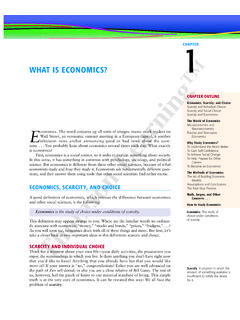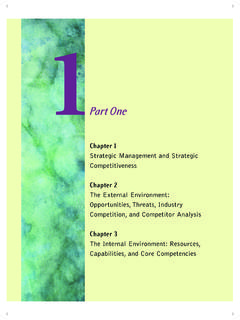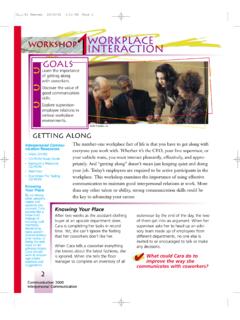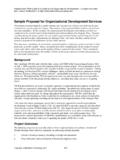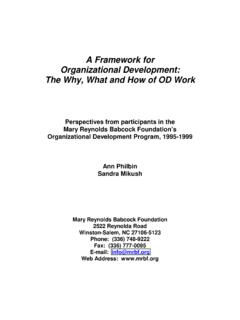Transcription of Introduction to Management - Cengage Learning
1 Thomson Learning PART1 Introduction to ManagementChapter OneManagement2 Chapter TwoOrganizational Environments and Cultures36 Chapter ThreeEthics and Social Responsibility 74 Thomson Learning CHAPTER1 What Would You Do?What Is Management ?1. Management Management Making Things Meeting the Organizing People, Projects, and LeadingWhat Do Managers Do?3. Kinds of Top Middle First-Line Team Leaders4. Managerial Interpersonal Informational Decisional RolesWhat Does It Take to Be a Manager?5. What Companies Look for in Managers6. Mistakes Managers Make7. The Transition to Management : The First YearWhy Management Matters8.
2 Competitive Advantage through PeopleWhat Really Happened?Key TermsWhat Would You Do-II? Management Decisions Develop Your Managerial Potential PHOTODISC/GETTY IMAGEST homson Learning oneManagementWhat Would You Do?Headquarters, NextJump, Inc., NewYork, New York. Charlie Kim started hisnew company, NextJump, after an ex-hausting two years at Morgan Stanley, aNew York investment bank, where heworked 80-hour weeks. Kim figured thatmost people left Morgan Stanley for jobsat companies that allowed them to havepersonal lives. People were working un-til 1 , drinking coffee, eating junk, he says, and they were miserable.
3 Kimcommitted to run NextJump in a fairway for employees. He backed up hiscommitment by not allowing employeesto work late nights or weekends. He said, I don t want anyone to be drained or ex-hausted. And unlike many tech startups,beds, cots, and futons weren t Kim, If you need to sleep, youshould go home. Alice Park, NextJump sdirector of product development, saidgetting kicked out of the office by theboss was a little strange to me at first. Ihad come from an investment bank,where it seemed normal to work until 9or 10 at night. But people here have adifferent style of working. Kim also figured that work would bemore fun if everybody knew each other,so within a year, he brought in three ofhis friends as partners.
4 This partnershipworked so well that NextJump continuedits policy of hiring friends. As NextJumpgrew from 30 to 105 employees in justthree months, its employees ended upworking with their college roommates,their prom dates, and their brothers andsisters. The company even displayed a di-agram of a family tree, which showedhow everyone in the company was con-nected to everyone else. As a finishingtouch to making NextJump a great placeto work, Kim bought gym membershipsfor everyone (and then encouraged themto work out whenever they wanted) andhired a masseuse to give massages oncompany time.
5 For a while, NextJump was a goodcompany and an even better place towork. But problems soon emerged. Keypeople often missed important meetingsbecause they were at the gym. Further-more, even when everyone could attend,staff meetings became turbulent, toolarge, and disorganized. Meetings hadbeen well run when the company wassmall, but now they turned into argu-ments about key company decisions,such as determining which products tosell, or whether the company should of-fer print products in addition to those itsold online. These problems were com-pounded when employees openly ques-tioned the decisions of Management andanyone else outside their small circle offriends.
6 Peter Rommeny, NextJump s for-mer HR director, said, You have a groupof five, six, ten people all best friendswho went to school together. If one getsdisillusioned, it affects the rest of thepeople in that You kind ofhave to walk on eggshells to provide dis-ciplinary conversation or you say to one person will getout to everyone else in the group. After several months of continuousgriping and out-of-control meetings, afrustrated Charlie Kim fired a dozen em-ployees who he felt were at the root ofthe problems. He said, We were spend-ing too much time managing negativepeople. But because of the tight friend-ships in the company, most of which hadexisted before people were hired, anotherhalf-dozen people immediately and company performance plum-meted.
7 Instead of making things better,the firings made them much worse. Kimlost sleep and became depressed. Slowly he came to the realization thathe, too, needed to change for the com-pany to succeed, that what had workedwhen the company had just 10 employ-ees was not going to work when it had130. After some encouragement fromfriends, advisors, and investors, he beganto consider the following issues: Whatare my primary responsibilities as a topmanager? Does that include keeping work-ers happy and comfortable? Making theThomson Learning The issues facing Charlie Kim and NextJump are fundamental to any organization:What is Management , and what do managers do?
8 Good Management is basic to startinga business, growing a business, and maintaining a business once it has achieved somemeasure of chapter begins by defining Management and discussing the functions of man-agement. Next, we look at what managers do by examining the four kinds of managersand reviewing the various roles that managers play. Third, we investigate what it takes tobe a manager by reviewing Management skills, what companies look for in their man-agers, the most serious mistakes managers make, and what it is like to make the toughtransition from being a worker to being a manager.
9 We finish this chapter by examiningthe competitive advantage that companies gain from good Management . In other words,we end the chapter by Learning how to establish a competitive advantage through people. What Is Management ?Have you ever noticed the difference between good and bad auto repair shops? Differ-ences usually start with the service manager who greets you when you bring in your that most people don t know much about cars, good service managers askdozens of detailed questions about the car s problems, what it does, the noises it makes,and the circumstances under which the problems occur.
10 When DaimlerChrysler wantedto make sure that all of its Chrysler dealerships had good service managers, it hired amanagement consulting firm to create the ServiceAnalyzer, a computer-based tool thathelps service managers at all Chrysler dealerships intuitively walk customers through aseries of questions that fully describe the car s problem and when it occurs. Daimler-Chrysler used the ServiceAnalyzerto solve problems and improve customer what DaimlerChrysler was paying for when the ServiceAnalyzerwas created wasgood Management course, DaimlerChrysler isn t the only organization insearch of good Management ideas.
